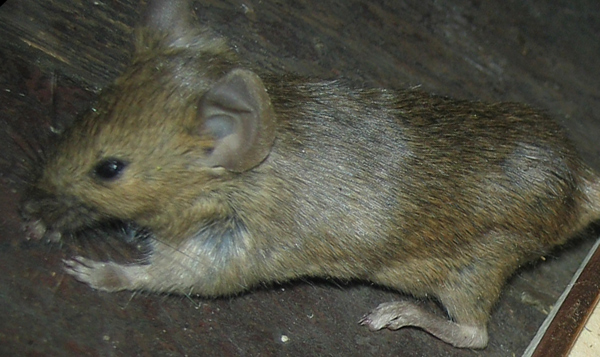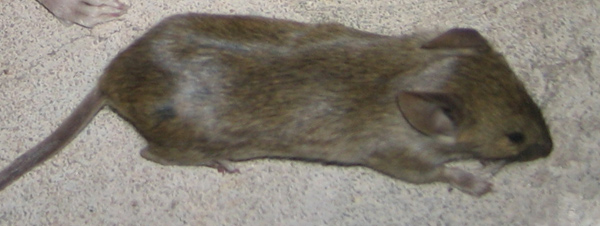- info@wildlife-removal.com
Call us for help in your town
Wildlife Removal Education
About House Mice
Need groundhog removal in your hometown? We service over 500 USA locations! Click here to hire us in your town and check prices - updated for year 2020.
Subspecies of Mus musculus are Mus musculus genticulus, Mus musculus domesticus, Mus musculus castaneus, Mus musculus musculus and Mus musculus bactrianus. These subspecies are all closely related with little distinguishing features. Other popular species of mice apart from house mouse are wood mouse, field mouse, deer mouse, zebra mouse etc.

House mice bear somewhat weird names as their adult males are called bucks, adult females are does while their babies are named pinkies (obviously due to their colour) or pups. They are naturally predated by wild cats, domestic cats, foxes, birds, large lizard, hawks, owls, snakes, ferrets and so on.
Appearance
The house mouse is a small animal with small naked ears, pointed snout, a long, hairless tail and short fur on most parts of its body. They generally vary in length from 2.5 cm to about 18 cm, and about 15g to 25g in body weight. The smallest known species of house mice is the African Pygmy mice.
House mice also vary widely in their coat, with fur colours ranging from light brown to dark brown, white and black, but their bellies are usually white. The young ones are born pink and their colour changes as they mature.
Diet
House mice are omnivorous, capable of consuming both vegetables and meats. They consume fruits, seeds, grains, vegetables, insects, meats, leftovers of pet meals, garbage, cooked food crumbs, and what have you. In rare cases of food scarcity, they go cannibalistic and eat fellow house mice too. They eat in bits, and up to 20 times in a day. They also store up large quantities of food to be eaten later.
Behaviour
Mice are highly sociable animals, living together in small communities often headed by a male, who practices polygamy and forms a small but marked territory with a few females and young ones. When this male dies, another male quickly moves into that territory to head the community.
House mice are also nocturnal, hence they mostly forage at night with very moderate or nil activity during the day. They are good jumpers, swimmers and burrowers too; and all of these attributes make getting rid of house mice difficult when they infest a house. They communicate with both ultrasonic and normal audible sounds among themselves.
These social animals sometimes have a close commensal relationship with man in which they gain and man neither gains nor loses. This is excepting cases where they destroy walls, cables and installation while looking for foods. Due to their abundance, they are regularly used as laboratory animals by scientists for various scientific or behavioural experiments and they are seldom kept as pets.
Habitat
These pests are cosmopolitan, that is they can be found almost everywhere with the exception of the Antarctica because of its extreme weather conditions. They have been found in forests, grassland, bushland, rainforest, temperate forest etc. They also live comfortably around men as long as food is available. In human dwellings, they make their homes in attics, roofs, stores, kitchens, farms, barns etc., as long as they find foods and encounter little or no disturbances from humans or predators.
Life cycle
The average lifespan of a house mouse is 3 years, or 2 years in the wild. They start breeding after 4 - 7 weeks of being born and are polygamous. As such, the male can mate with any female in the community. Gestation period lasts for an average of 20 days, after which they give birth to about 4 - 12 pups. House mice are great breeders and can breed every 5 weeks.
Pups, also called pinkies, are born naked, pinkish and underdeveloped with ears and eyes closed until 15 days after birth when they open their eyes. They develop fur on their bodies by the 10th day of birth. The mature females have mammary glands and nipples like other typical mammals which they use to feed their young ones. The mother takes care of them for a few weeks, after which they become independent and start to breed too.
About House Mice
As the name of the species suggests, this type of mouse is one that is common in urban areas and places where people can be found, and it is a species that has adapted to live alongside humans successfully. There are a number of problems that the species can cause for people, but it is also worth noting that the majority of pet mice and laboratory mice originate from this variant of the species, having been domesticated over the centuries.

Appearance
The house mouse is usually between three and four inches in length without the tail, which adds another two to four inches to the overall length of the rodent. It has short soft hair and small white paws with five fingers, while the eyes are usually dark brown or black, except in the case of white mice which will often have red eyes.
Biology
Mice do not have eyes as strong as people, meaning that they have fewer colors that they can see, but one of the remarkable aspect of the species is that they can see ultra violet light, which is a different proposition. The house mouse also uses pheromones produced by the glands to communicate with other mice too.
Life Cycle
The house mouse is born without fur or ears, and cannot even see, and is usually one of a litter of up to fourteen pups. Females and males are both adult after around eight weeks, and while many will die, those who do grow to adulthood can sometimes live for between two and three years, during which time they can mate and give birth several times.
Habitat
The house mouse is found in many areas of the world, particularly Europe and North America, although it isn't really present in Central Africa and Northern Asia. The mice will live in domestic and commercial building where people are present.
Diet
One of the key aspects of the house mouse is that it is generally vegetarian, eating seeds, grains and any vegetables that they can locate in and around their habitat. They are also a species that will consume its own feces, to get the nutrients produced by bacterial activity in their intestines.
Behavior
The house mouse has a natural aversion to bright lights, which is why it usually lives in the dark cavities in walls and other areas around the home. They are also known for standing on their hind legs, which they do with support from the tail, which is used to gain a perspective on their surroundings.
Go back to the Mice Removal page.


















